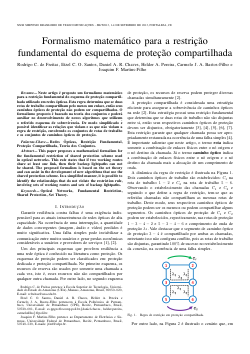
XXXI Simpósio Brasileiro de Telecomunicações

Virtual Cell Zooming and Sleep Mode for 3GPP-LTE Green Cellular Networks
Bruno Saldanha Carminati, Marcelo Faleiros Costa, André Noll Barreto
DOI: 10.14209/sbrt.2013.131
Keywords: Cell Zooming Energy Efficiency G reen Cellular Networks Power Management.
Abstract
This paper presents a study on green cellular networks for 3GPP-LTE networks, comparing the performance of the sleep mode and cell zooming algorithms not only in terms of their energy efficiency, but also verifying whether energy savings do not cause coverage or throughput losses in the network. In order to perform this study, we have developed a radio network simulator, which accounts for the traffic variation of a cellular network over the day and over different regions of the grid. Because of performance and implementation limitations of the cell zooming algorithm found in the literature, we propose a modification, called virtual cell zooming.Download

Codificação de Rede na Camada Física via Reticulados
Danilo Silva
DOI: 10.14209/sbrt.2013.132
Keywords: Cooperative communications wireless networks network coding nested lattices
Abstract
Physical-layer network coding (PNC) is a relaying strategy for wireless networks that exploits interference as an aid — rather than an obstacle — to communications. A promising type of PNC based on nested lattices is attracting significant attention due to its several advantages, both theoretical and practical. This invited paper summarizes some of the recent work in this area obtained by the author and his collaborators (Feng, Silva & Kschischang, IEEE Trans. Inf. Theory, 2013). Specifically, an algebraic framework for PNC is presented, based on module theory, which is applicable to any pair of nested lattices. Error probability expressions and design criteria are derived for general lattices and then specialized for lattices based on Construction A.Download

Efeito de não linearidade variante no tempo sobre o espectro de sistemas OFDM móveis
Alexander Beremiz Hilario Tacuri, José Mauro Pedro Fortes
DOI: 10.14209/sbrt.2013.128
Keywords: OFDM não-linearidade com memória canal muti-percurso.
Abstract
Este artigo apresenta um desenvolvimento analı́tico que permite analisar o efeito, sobre o espectro de sinais OFDM, de um canal constituı́do por uma não linearidade com memória seguida por um canal de propagação muti-percurso. O canal é modelado por uma série de Volterra variante no tempo e a envoltória complexa do sinal OFDM por um processo estocástico gaussiano próprio, complexo, ciclo-estacionário e de média nula. As expressões matemáticas obtidas são aplicadas a uma situação especı́fica, permitindo uma avaliação quantitativa do espalhamento espectral de sinais OFDM provocado pela utilização de dispositivos não lireares em canais moveis.Download

Codificação para o Canal Gaussiano de Múltiplo Acesso
Marco Cazarotto, Renato da Rocha Lopes
DOI: 10.14209/sbrt.2013.133
Keywords: Gaussian Multiple Access Channel Low Density Parity Check Shaping Fourier Transform.
Abstract
In this paper we propose a coding strategy for the two-user Gaussian Multiple Access Channel. We are interested in the problem from the point of view of the detection of the first user, which will treat the signals from the other user as noise. This strategy is known as Successive Interference Cancellation (SIC). Our coding scheme is based on the Low Density Parity Check (LDPC) codes. On detection, LDPC assumes that the noise is Gaussian. This is not true for the first user, if, e.g., the other user uses 2-PSK modulation. Therefore, we propose two new strategies to modify the second user’s distribution, aiming at making it more Gaussian. The first strategy will utilize Shaping and the second one is based on the discrete Fourier transform. We will show that both strategies outperform the strategy of using a 2-PSK modulation for the second user.Download

Identificação de Ofensores em Redes IEEE 802.11 Utilizando Lógica Nebulosa
Claurem P. C. Marques, Ana R. C. Siqueira, Deivis F. Pirani, Thalis Avansi, Marcelo L. F. Abbade, Alexandre A. Mota, Lia T. M. Mota
DOI: 10.14209/sbrt.2013.129
Keywords: MAC Anomaly IEEE 802.11 Fuzzy Logic test workbench.
Abstract
This paper presents a method to identify devices causing the MAC anomaly in IEEE 802.11 networks using fuzzy logic. To do so, a test bench with specific hardware and software configuration was implemented, that allows gathering of information needed to determine transmission power and throughput of network stations. With these data, a fuzzy system was developed to determine an offensive potential for all network devices, permitting to identify the probable offending device.Download

LTE Pico Nodes Indoor Deployment Aspects
Khaled Ardah, Yuri C. B. Silva
DOI: 10.14209/sbrt.2013.134
Keywords: Indoor deployment heterogeneous network.
Abstract
Technology evolution over the last few years added many demands on mobile networks. To be able to support new requirements and to keep customers satisfied, network operators need to increase the capacity, coverage, and performance of their networks. Recently, low power nodes have appeared in the Long Term Evolution (LTE) context as a promising method to satisfy future demands. In this paper, the 3 rd Generation Partnership Project (3GPP) indoor pico model for LTE heterogeneous networks is investigated by means of simulations for different scenarios to better understand the impacts of wall penetration on coverage area, load balance and system performance. It has been found that the coverage area of pico nodes is limited in the indoor environment. In most cases, the transition zone area (i.e., where the optimal cell selections differ in downlink and uplink) is covered by a building wall. Users in an indoor transition zone area have lower degradation in their Signal to Interference-plus-Noise Ratio (SINR) levels compared to users in outdoor area. Since low power nodes are more protected to interference and so have better channel conditions than macro nodes, low power nodes are able to handle a greater traffic load.Download

Formalismo matemático para a restrição fundamental do esquema de proteção compartilhada
Rodrigo C. de Freitas, Etzel C. O. Santos, Daniel A. R. Chaves, Helder A. Pereira, Carmelo J. A. Bastos-Filho, Joaquim F. Martins-Filho
DOI: 10.14209/sbrt.2013.135
Keywords: Optical Networks Fundamental Restriction Shared Protection Set Theory
Abstract
This paper proposes a mathematical formalism for the fundamental restriction of shared protection scheme used in optical networks. This rule states that if two working routes share at least one link, then their backup lightpaths can not be shared. The proposed formalism is based on the set theory and can assist in the development of new algorithms that use the shared protection scheme. In a simplified manner, it is possible to identify the relationships that do not violate the restriction rule, involving sets of working routes and sets of backup lightpaths.Download

Estudo Paramétrico da Antena de Microfita Retangular com Duas Fendas Paralelas.
Felipe Welke, Roger L. Farias, Marcos V. T. Heckler.
DOI: 10.14209/sbrt.2013.136
Keywords: Antenas antenas de microfita GSM telefonia móvel celular.
Abstract
Este artigo apresenta resultados do estudo de uma antena em tecnologia de microfita com o patch em formato de E. Os principais resultados do estudo paramétrico dessa antena são apresentados, destacando-se os efeitos da variação das dimensões da antena.Download

Cooperação com Codificação de Rede Aplicada a Redes Veiculares MIMO com Enlaces Assimétricos
Ohara Kerusauskas Rayel, João Luiz Rebelatto, Richard Demo Souza, Bartolomeu F. Uchôa-Filho
DOI: 10.14209/sbrt.2013.142
Keywords: Comunicação cooperativa MIMO codificação de rede redes veiculares.
Abstract
Este artigo avalia a aplicação de codificação de rede não-binária a uma rede veicular cooperativa ad hoc (VANET), cujos veículos são providos de múltiplas antenas (MIMO). Considera-se desvanecimento Nakagami-m, possibilitando avaliar a confiabilidade do esquema proposto com destaque para o caso em que a condição do canal é crítica (sub-Rayleigh com m < 1). Os benefícios tanto de códigos espaço-temporais, como de comunicação cooperativa são utilizados para aumentar a ordem de diversidade da rede, e consequentemente proporcionar comunicação mais confiável. A probabilidade de outage é obtida analiticamente, inclusive em cenários com canais inter usuário desbalanceados e resultados numéricos mostram que codificação de rede pode aumentar consideravelmente a confiabilidade do sistema.Download

Avaliação das Características de Amplificação de Fibras de Telurito Dopadas com Érbio e Itérbio
Thisien G. Montes, Enver F. Chillcce, Luiz C. Barbosa, Aldário C. Bordonalli
DOI: 10.14209/sbrt.2013.143
Keywords: amplificação óptica comunicações ópticas vidro telurito.
Abstract
Amostras de fibra de vidro telurito dopado com érbio e itérbio foram avaliadas empiricamente em relação às suas propriedades de amplificação óptica. Tendo como base as configurações do amplificador óptico a fibra dopada com érbio, amostras de diferentes comprimentos foram submetidas a potências de bombeio de valores distintos. Como resultado, pode- se verificar que valores de ganho óptico da ordem de 30 dB foram alcançados com bombeio bi-direcional da ordem de 100 mW, para amostras de apenas 2 cm. Além disso, a interação entre a matriz vítrea com o érbio e o itérbio fornece transições que levam a larguras de banda de 3 dB para o espectro de ASE que podem chegar a 70 nm, dependendo da configuração de bombeio, mostrando o potencial de aplicação dessas fibras como amplificadores ópticos.Download